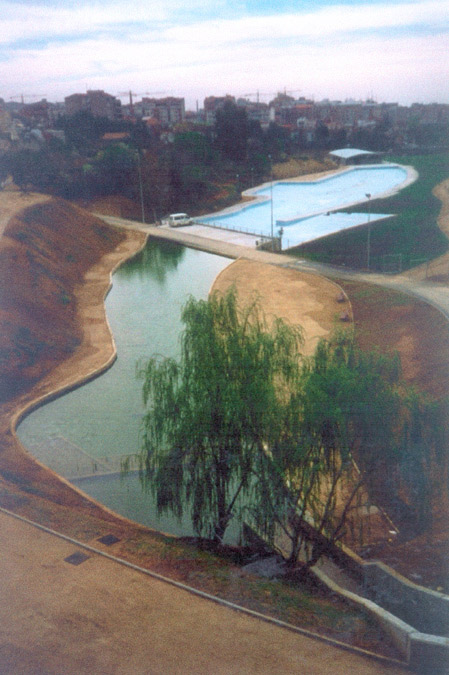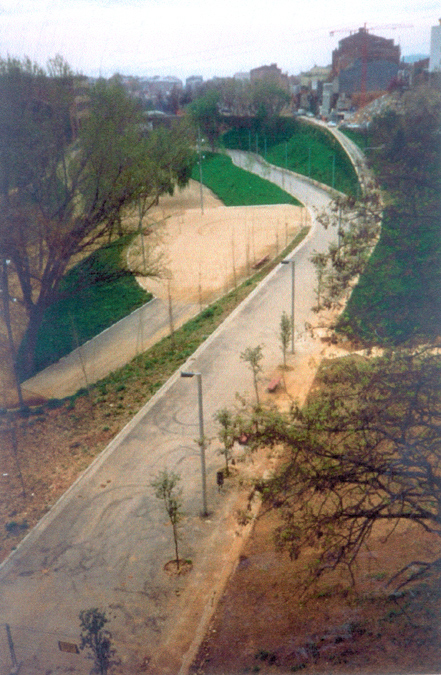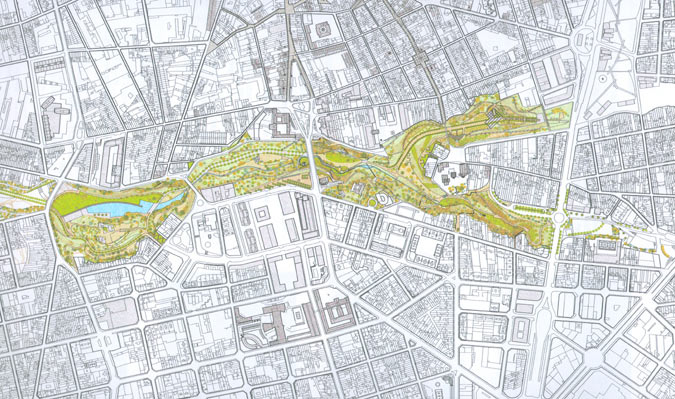Previous state
The Vallparadís torrent maintained its location on the periphery of Terrassa until the expansion of the city increased, from the fifties onwards. The site has been occupied throughout history, and this is reflected in the number of heritage sites along the course of the torrent. Until the thirties, there was a nucleus of houses in the sector known as the "Sot del Pi", which was demolished with a view to building the Parc Vallparadís, which had been planned since the turn of the century by the municipal architect. The park project did not prosper and the Vallparadís torrent became an unchecked dumping ground (with the exception of its southern sector which was occupied by allotments) and an urban fracture surrounded by the city of Terrassa. When the Special Plan for the Parc Vallparadís was drawn up in 1987, it highlighted the high levels of deterioration in the torrent's vegetation. From an environmental viewpoint, the site's value as a whole was not particularly noteworthy, but its location, in the middle of the city, gave it a unique value which justified its recovery.
Aim of the intervention
The central aim of the intervention was to convert the former torrent into a city park which would contain all those elements which would ensure its optimum use.
Firstly, this involved the removal of the existing refuse dumps along its course, and the thorough cleaning of the existing solid waste so that the residents would lose the habit of using it as a dumping ground.
Making the space accessible was one of the priorities since some sections of the torrent form a genuine furrow which is narrow in comparison with its depth, thus providing a sharp contrast to its great length. One of the other important factors was the preservation of the natural resources of the torrent which, despite their deterioration, featured a number of interesting trees -large elms and poplars- and, as a whole, were well-suited to the conditions of the site. Furthermore, the preservation of the most valuable vegetation represented a saving in the cost of creating the park. Lastly, a closer link needed to be fostered between the future park and the different monuments along its route, mainly the series of churches in the old quarter of Sant Pere, the castle and museum.
Description
The project to convert the damaged natural space into a park began in the northern sector of the torrent, which includes the two stream beds and is the site of the churches of Sant Pere and Vallparadís Castle. Due to the topography of the site, the project was based on the creation of a pedestrian walkway which would run the length of the torrent from north to south and become the linking element of the park.
This walkway is, and will be, extremely varied as it will alternate between clumps of woodland, open areas suitable for landscaping, allotments and ponds. This latter element plays a key role in the project since the watercourse has been reestablished on the torrent bed, supplied, in part, by the springs in the northern sector: water which will run into the artificial lake to be created in the central zone of the park.
The new natural space is made accessible due to the relationship established between the edges of the park and the city; this is based on the improved visuality of its interior, through the urbanised intermediate areas which are usually linked to the park's heritage sites, and the proliferation of entrances via pathways reserved for pedestrians, which are also suitable for the disabled. For this reason, the routes on the perimeter with views over the park have been improved, both for vehicles and pedestrians.
The way in which the relief of the site has been dealt with is also one of the most important elements of the project. The designers have sought to avoid the feeling that the bottom of the torrent is set below, and isolated from, the city
Therefore, the fragile gullies on the perimeter have been strengthened through the creation of gently sloping banks which feature vegetation as well as the entrances via ramps and staircases.The preservation of vegetation has been fundamental in this northern sector.
Assessment
From an insurmountable urban fracture to a public space. Although the conversion of the torrent into a city park has not yet been completed, the northern sector, which is currently open, has already taken on its function as a green facility due to its central location with regard to the city. Furthermore, it has quickly been adopted by the inhabitants of Terrassa, who walk there and use the recovered space for a wide range of activities. A number of interesting elements and attractions have been installed along its route, such as the miniature railway, picnic areas, etc.
By respecting the existing vegetation, this completed sector has unusually lush vegetation in a newly created green area. Once the park has been completed, Terrassa will enjoy a truly central park with a special feature: it offers an extensive route which is accessible without cutting through areas of buildings.
Mònica Oliveres i Guixer, architect
[Last update: 07/06/2023]








